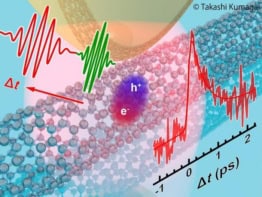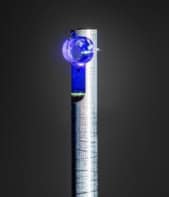Adam Kollin and John Keem of RHK Technology explain how their firm is helping physicists get the most from scanning probe microscopy
What do robotic manufacturing, global positioning systems and artificial intelligence have in common with scanning probe microscopy? A lot more than you might think — at least according to Adam Kollin and John Keem of the US-based firm RHK Technology. Founded 20 years ago by Kollin, the company makes software and hardware systems for ultra-high-vacuum scanning-probe microscopes (SPMs) — as well as the microscopes themselves.
The first scanning probe microscope (SPM) was built in 1981 by Gerd Binning and Heinrich Rohrer at IBM’s research labs in Zürich, for which the pair were awarded the 1986 Nobel Prize for Physics. SPMs work by scanning a tiny tip across a surface and then creating an image from measurements made at regular intervals. Although Binning and Rohrer measured the electric current that tunnels between tip and surface, modern-day SPMs can take other data too — including optical and magnetic-force measurements.
To ensure that the appropriate measurements are made, all SPMs need sophisticated controllers to ensure that the tip is in the right place at the right time. Now, however, RHK is about to launch its fully digital next-generation controller, dubbed R9, which does away with the myriad jumper cables associated with many physics experiments. It replaces them with virtual instruments implemented in field-programmable gate arrays (FPGAs) — digital processors that can be reprogrammed on the fly. Designed for specialists and novices alike
According to Kollin, who is president of the company, the overall goal of R9 is to deliver a system that is both “enabling and engaging” to the user. This is a challenge because the company’s controllers and SPMs are used by many different people — from those who specialize in making precision spectroscopic measurements on tiny nanostructures to physicists who only occasionally use an SPM to characterize samples destined for other uses. Some of the firm’s controllers are even used by graduate students who have never seen an SPM — let alone used one.
And, of course, any controller worth its salt must deliver on the fundamental challenge of SPM — moving a tiny probe tip around a surface with picometer accuracy while measuring extremely small but crucial values.
With previous controllers, RHK set out to produce a system that could be used to control any SPM. This was a radical approach at a time when other companies made controllers specifically for their own instruments. Kollin’s solution was to integrate all the requisite electronics in a single cabinet and use internal jumper cables to allow the user to set the appropriate configuration for a specific microscope making a specific measurement.
“We could run any kind of microscope and no one to this day can do that,” explains Kollin.
“The greatest strength of our software was that it was written by a research physicist — and its greatest weakness was that it was written by a research physicist” Adam Kollin
While this approach was very flexible, Kollin is the first to admit that it was not particularly engaging. Indeed, the prospect of rearranging a jumble of jumper cables to modify an experiment could be challenging to student and veteran alike. The software that ran the controller was also becoming too deep and complex for the novice. As Kollin quips, “the greatest strength of our software was that it was written by a research physicist — and its greatest weakness was that it was written by a research physicist”.
“Technically the measurements were correct — and it was far better and more capable than any other instruments that people were using before”, continues Kollin. The problem is that the system had so many menus that very few users had the time or energy to figure out how to exploit the full value of the system. “We were pouring millions of dollars into the software and the less demanding user-physicist treated it like Microsoft Word — they use the equivalent of spell-check and print and ignore the other 99.9% of its capabilities.”
According to Kollin, the software’s menu-based system and the jumble of jumper cables did not provide the user with a good understanding of what the controller was actually doing. “There was too steep a learning curve for casual users,” he explains. “We were losing sales in this sector — potential customers were complaining ‘my students will never figure this out’. After being told this a few times, Kollin committed the company to making a system that is easy and fun to use for a novice — but that still offered the experienced user the power and flexibility to do their own highly specialized experiments.
Continuous knowledge
To do any SPM experiment, a user must first configure the microscope, which means understanding what all those jumper cables do so they can be connected properly. “With R9 you can do this graphically on a computer screen,” explains Kollin. “If you want one piezo tube [an actuator that controls the position of the SPM tip] you drag its icon over with the mouse. Or you can drag over two — software knows that if you have two tubes, then you need controls for both.”
“Every real experiment that gives real data in a real amount of time has a unique configuration vector” John Keem
Once the microscope has been configured, the system can then be set to gather data in myriad different experimental configurations. According to Keem, who trained as a physicist and is now RHK’s engineering project manager, the “core intellectual construct” used by R9 to keep track of all the parameters in an experiment is a “configuration vector” — which defines the entire state of the experiment as one point in a phase space of parameters. “Every real experiment that gives real data in a real amount of time has a unique configuration vector,” explains Keem.
This vector — which includes all input parameters to the SPM; excitations made on the sample and how it responded; as well as the algorithm that is operating the system — is recorded every 20 ns and stored using data-compression techniques.
As a result, a physicist can know exactly what was going on in the experiment on a continuous basis, rather than seeing a SPM image as a time-averaged representation of the sample. “A real SPM experiment can never be a snapshot,” explains Keem. “The reality is that each point in the image is taken at a certain time and the next point is taken a little bit later, and under slightly different conditions. We keep that information, whereas all other systems throw much of this valuable information away. It’s really exciting to be able to offer that to physicists.”
Big benefits
As well as being useful for studying dynamical processes, Keem says that this time-series approach could also help researchers use SPM to manufacture nanostructures. “Let’s say a nanostructure can be built today in one minute using an SPM — but you want to build 1000 structures in a second. This is unachievable unless you understand the time-dependent nature of how the structure responds to the SPM during the building process — information that can then be used to create a highly efficient manufacturing process.”
Another benefit of constantly monitoring all experimental parameters is that a measurement can be made as soon as the position of the tip is in the right place to a desired precision — and then the system can move on to the next point. The time spent waiting for the tip to settle down is often chosen arbitrarily by the researcher. If it is too short precision is lost; too long and precious experimental time is wasted. Instead, R9 makes these decisions using real-time data and artificial intelligence algorithms.
Such algorithms are used routinely today in technologies as diverse as mobile-phone networks, precision milling machines and even particle accelerators and telescopes. However, they are normally not used by condensed-matter physicists, chemists and biologists — even though commercial tools are available to build these systems very quickly. “We have found a way to allow our customers to benefit from these well developed tools,” says Kollin.
To get the most out of these technologies, RHK has teamed up with Oakland University in Michigan to create a nanotechnology lab that focuses on the development of adaptive control systems for SPM. The lab brings together physics, computer science and mechanical engineering students to work on problems such as performing a finite-element-analysis of an SPM to see if models used to develop adaptive controls are accurate.
“Mechanical engineers know about optimizing a 17° of freedom system and holding it to 0.01% accuracy,” says Kollin. “We need these people to help us get there on our SPMs.”
But for Kollin, developing R9 has been just as much about re-examining how physicists usually solve experimental problems. “Physicists are using 20th-century tools to solve 21st century problems. We know that 21st-century tools are available,” he concludes. “With R9 we can now reconfigure systems on the fly, where physicists would shut down the experiment to reconfigure it.”
R9 will be released later this year.




